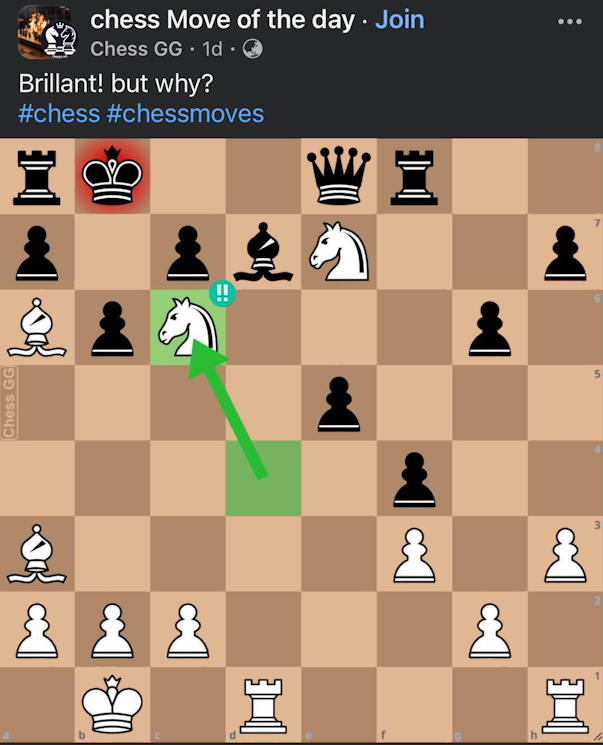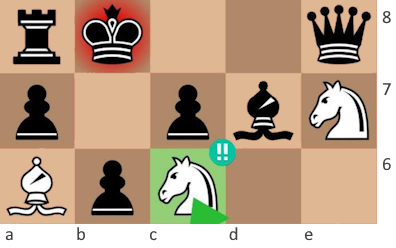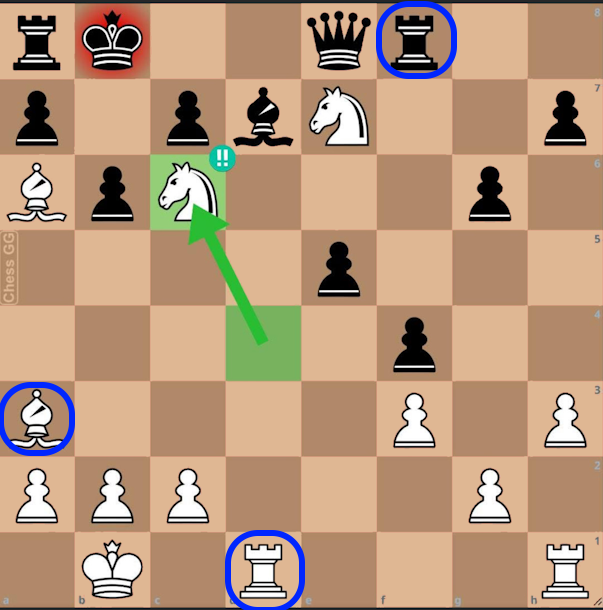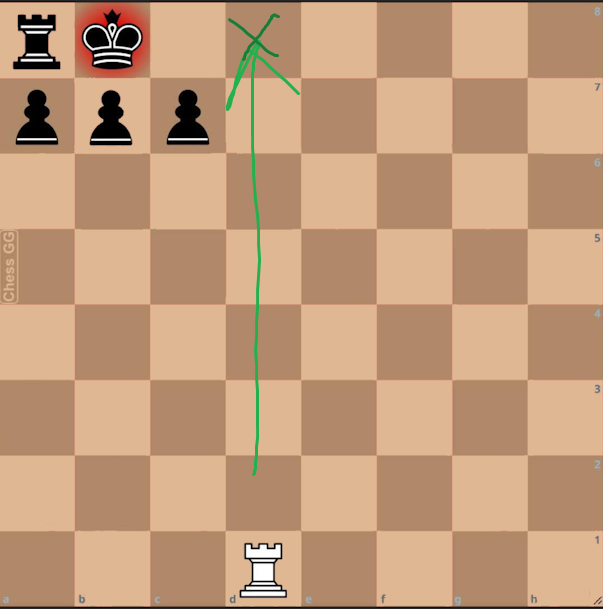Outbound Links
- multi-armed bandit algorithm
- 🖼️ chess_move_of_the_day_example_50.png
- nerd-sniped
- ⭐ joke-genious
- 🖼️ chess_move_of_the_day_example_50.png
- "long algebraic notation"
- CSV
- zugzwang
- 🖼️ chess_move_of_the_day_example_top_corner_labels_50.png
- 🖼️ chess_move_of_the_day_example_50_pullback.png
- 🖼️ back-rank-checkmate.png
- WP: Algebraic notation (chess)
- WP: Zugzwang
- xkcd: Nerd Sniping
- ⭐ joke-genious
- secretGeek/AwesomeCSV: 🕶️A curated list of awesome tools for dealing with CSV.
- ⭐ dependency-graph-for-knowledge
Chess Literacy
I don't really want to write about "Chess literacy", I want to write about "Science literacy". But I don't think I can get my thoughts in order on "Science literacy" until I deal with "Chess literacy".
At some point, a multi-armed bandit algorithm deep inside Facebook's attention-optimising machine decided to show me a post about a "Chess move-of-the-day".

(this is not the first "chess move-of-the-day" example I saw, but will suffice to illustrate the topic)
I stopped and looked at it for a while, to understand what the move was, what the next move was, etc. And quickly found myself nerd-sniped into concentrating very hard on that chessboard, trying to understand what I should see.
The algorithm noticed how engaged I was with this "chess move-of-the-day" suggested-content, and my Facebook feed was soon stuffed to bursting with one chessboard after another. I couldn't scroll half a screen without finding another one, and another. And I would stop in my tracks to analyse each chessboard, forgetting entirely why I was on Facebook in the first place.
After a while, I noticed that my brain had begun to pattern-match certain things quite quickly, and I realised that grokking a "chess move-of-the-day" is somewhat like understanding a joke. A joke will get you to think one thing is true or likely, and then, at the punchline, you will re-evaluate what you were expecting and find a different truth. A "chess move-of-the-day" will usually make a specific "wrong move" very obvious, but you learn to look deeper — and eventually when you discover the "real" trick, your brain receives a little reward, a little payback for its efforts.
I've never been a "devoted" chess player. I learned the rules when I was a child (except en passant I guess) and this is enough for me to slowly pick apart a chessboard. But "Chess literacy" implies a kind of fluency. And the fun thing for me has been observing how, with repeated analysis of "chess moves-of-the-day" certain patterns leap out.
Here's the example I'll use to help get to the point of this story:

First, a novice player like me will notice that the white knight has the black king in "check". Or to be more truthful, a player like me will spot that the little white horsey piece is threatening the little black king piece. (The red glow is a big hint and helps direct the attention.) But straight after that the novice will readily see that the knight can be taken out by the black bishop, hence the check is not a checkmate. Then, as a novice, your focus will zoom out a little, engulfing each piece in turn, and asking: 1. who it is currently threatening? and 2. who might it threaten on the next move?
An experienced chess player won't "read" the situation one chess piece at a time. They'll recognise whole chunks of the board at once, and they'll almost instantly "know" the state of the entire board, not just the part closest to the "action". An analogy here would be that a person with basic literacy, when reading a sentence, does not read each individual letter, slowly putting together the sounds into a single word. They "read" an entire word at a time, recognising the words.
Sometimes, if you can't work out what is going on with a "chess move-of-the-day", it pays to read the comments. There are usually a lot of comments at this kind of post. Reading the comments is of course a major hazard in our modern world. But we press on.
Invariably you will find someone confidently claiming the wrong solution. And the confident but wrong comments will be easy to read, e.g.
Confident but wrong solution:
Bishop takes knight
Knight takes bishop
Checkmate
The fact the comment is written in plain English is a "tell" that it's probably wrong.
Meanwhile, the actual "informative" replies, and the best comments, will often be expressed as algebraic notation — that domain-specific-language (DSL) for describing chess moves. It might look something like this:
d7xc6, d1-d8+, e8xd8, e7xc6#
And that notation is a challenge to unpick, for the novice.
But if you can't read that notation, you won't learn much from "chess moves-of-the-day".
And learning to read algebraic notation is, again, like learning to read the chessboard, or learning to read in general: as first you can only proceed one letter at a time, crawling painfully through the sequence. Later, if you persist, you will read and understand each individual move at a glance, and later, presumably, achieve a higher state of fluency again. (This example uses "long algebraic notation")
Decoding this example d7xc6, d1-d8+, e8xd8, e7xc6# — it has four moves separated by commas (it is CSV!), and they are:
d7xc6— Black's response: piece atd7takes piece atc6. ('x' means "capture/take"). i.e. the black bishop takes the white knight, removing the check.d1-d8+— White's response: piece atd1moves tod8, and we are again in check, indicated by the+. i.e. the rook moves from bottom row all the way to the top row, threatening the king.e8xd8— Black's response: piece ate8takesd8, that is, the black queen takes out the white rook, removing the check.e7xc6#— White's final move: piece ate7takes the piece atc6, i.e. the remaining white knight takes out the black bishop, and this time it is not just a check, but a check mate, indicated by a#.
But slowly picking through all of that you won't help you "get" the joke. The joke in this case is one that only make sense when your Chess literacy extends to understanding a few words and phrases, not just some individual letters.
What's really going on
Here's the play by play —
At the start, we see the black bishop is forced to take the white knight. And as an appreciator of "chess move-of-the-day" you will intuitively know that this is a deliberate sacrifice (a sac as chess players call it), and more specifically it is almost definitely a zugzwang. (A zugzwang is when one player "forces" the other player to make a move, and it's a move that they would rather not make 1). In this case, black has to respond to the check. And the only legal response is for them to take the white knight. So that's what they'll do.
Black will know, without even looking at the rest of the board, that the bishop is being led into a trap. White has deliberately sacrificed that knight.
Casting our eye wider we see that the other white knight is conveniently positioned, ready to take the bishop, and get us right back where we started: the little white horsey piece threatening the little black king piece. Ho ho! A naive reader of "chess move of the day" will think. Ah-ha! That must be the punchline, the first knight failed, but the second knight will succeed. But not so fast, amateur chess kid.
Just as the second white knight was ready to attack the same way as the first white knight, and so the queen is ready to attack the next knight that attempts the same attack on her king. And there are no more white pieces threatening that square, so she is safe. Hence, our "confident but wrong" comment, needs to be amended.
Bishop takes knight
Knight takes bishop
Checkmate
But Queen takes knight! Oops!
And with that realisation, the whole campaign is in ruins. It's no longer clear what white's move should have been.
At this point, our mind is like the person who has heard the setup of the joke, noticed that the punchline does not fit the expectation established by the setup, but has not yet worked out what the punchline means, or why it is "funny". They have not yet "gotten" the joke, but they are close.
Here's a funny thing about the analysis we've conducted so far.
You may realise that all of the consideration has been entirely devoted to just the top left corner of the board. Nothing we've analyzed so far has required more than just these few squares:

And it is that myopia that will be vital to "getting" the joke. The type of joke we are very slowly unravelling here is a classic "pull back to reveal" joke.
Stewart Lee describes the "pull back to reveal" joke format for us, in his book, "How I escaped my certain fate".
There is a classic joke mechanism, called the Pull Back and Reveal, of which audiences never seem to tire, the fools. The first half of a sentence creates a certain set of expectations, concerning the location, age or social status of the participants in the story, which is then reversed in the second half of the sentence as the frame of the picture, so to speak, widens to include details which, had they been evident initially, would have clarified the situation immediately
Stewart goes on to provide two examples. But I'd rather you bought his book to find out what his examples were, and I will instead substitute this Jack Handey joke which is, for me, the canonical pull back and reveal joke:
When I die, I want to die like my grandfather who died peacefully in his sleep. Not screaming like all the passengers in his car.
— Jack Handey
Had the story been told the other way around, it would not have been a joke, just a very bleak perspective on a tragic event:
When I die, I don't want to die screaming in terror like all the passengers who died when my grandfather crashed his car after he fell asleep. I would rather be the one who is asleep.
— No longer a joke, now just a very bleak perspective on a tragic event.
When we "pull back to reveal" the entire board, it is these other pieces that are relevant to the punchline.

One particular "pattern" that should leap out to any one with any "Chess literacy" (and they would've spotted it long ago, and both players would've been sweating over it for the last few moves) is that this board is setup for something called a "back-rank checkmate", or a "corridor mate". One of the the best known ways to finish your opponent.
Consider this minimal example:

In a situation like that shown above, as soon as any rook reaches the back-rank (row 8) the king has no escape. He's trapped by his own pieces around him. (The same is true if the white queen reached the back rank).
In the "move of the day" we're analysing at the moment, you have to squint your eyes a little to see that the same pattern is present. But as soon as that black bishop is out of the way (which must happen), the white rook will have a clear run to the back. There isn't a row of pawns holding the king back, instead the white bishop has the king "pinned" in place.
However, that back row is not safe for the rook, as it would be in a perfect "back-rank checkmate" scenario. There are not one but two of the rooks worst enemies sitting right there, ready to foul up any attack: the black queen and a black rook. In fact it would be madness for even the most daring rook to attempt a back-rank checkmate.
The twist is that we have a two wrongs make a right situation in front of us.
The back row is doubly defended, much as, in the original naive attempt, two knights who try to attack the king, and each would be destroyed, as two pieces were defending that square in series. (Remember the black bishop would remove the white knight from C6, and the black queen would obliterate the next white knight who jumped onto C6.)
References
See also
- Joke Genious
- secretGeek/AwesomeCSV: 🕶️A curated list of awesome tools for dealing with CSV.
- Dependency Graph For Knowledge
-
Note that zugzwang is not quite as specific as the definition I gave above. There may be more than one move available to the player, but all moves are moves the player would rather not make. The critical thing is that they are punished by their need to make a move. In fact, zugzwang may not apply at all in the case given above, because even though the move only brings black closer to defeat, it is still preferable to not making a move. Because if black (somehow, in defiance of the rules of chess) did not make a move, the king would be immediately taken.↩